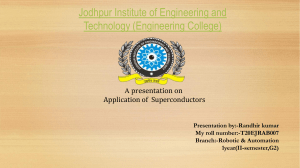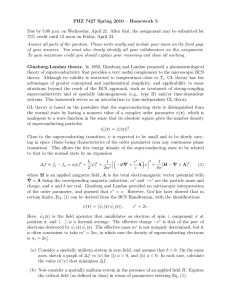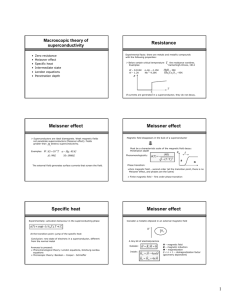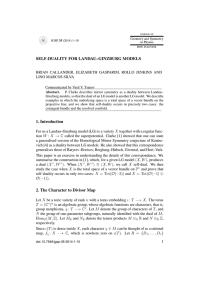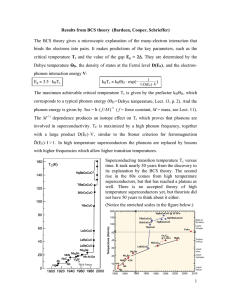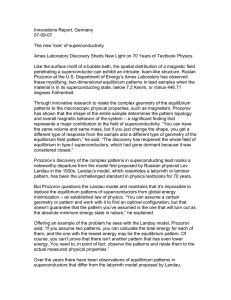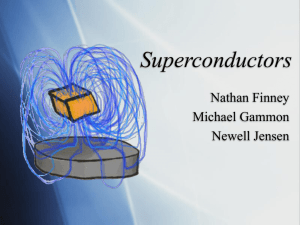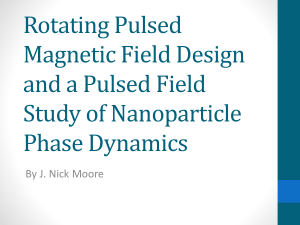Ginzburg-Landau Equation: Finite Element Method & Superconductivity
advertisement
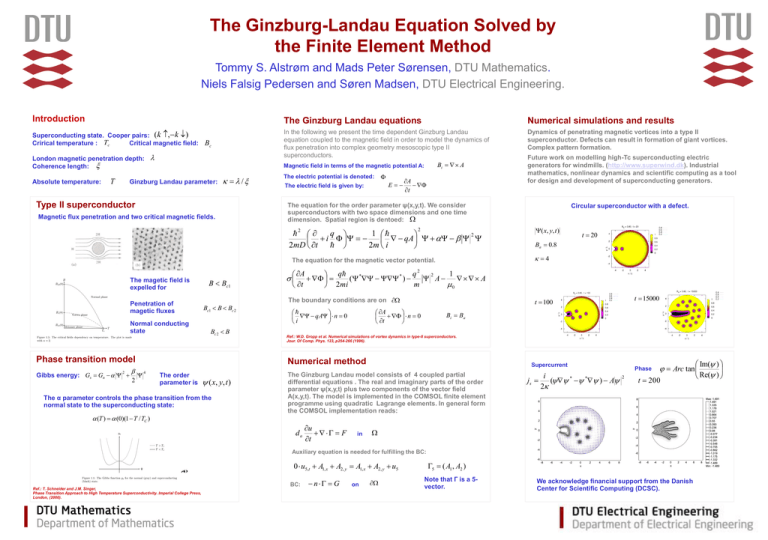
The Ginzburg-Landau Equation Solved by the Finite Element Method Tommy S. Alstrøm and Mads Peter Sørensen, DTU Mathematics. Niels Falsig Pedersen and Søren Madsen, DTU Electrical Engineering. Introduction The Ginzburg Landau equations Numerical simulations and results Superconducting state. Cooper pairs: ( k , k ) Crirical temperature : Tc Critical magnetic field: In the following we present the time dependent Ginzburg Landau equation coupled to the magnetic field in order to model the dynamics of flux penetration into complex geometry mesoscopic type II superconductors. Dynamics of penetrating magnetic vortices into a type II superconductor. Defects can result in formation of giant vortices. Complex pattern formation. London magnetic penetration depth: Coherence length: Absolute temperature: T Bc Bi A Magnetic field in terms of the magnetic potential A: / Ginzburg Landau parameter: Type II superconductor The electric potential is denoted: E The electric field is given by: A t The equation for the order parameter ψ(x,y,t). We consider superconductors with two space dimensions and one time dimension. Spatial region is dentoed: Magnetic flux penetration and two critical magnetic fields. q 1 2 i qA 2mD t 2m i 2 2 Penetration of magetic fluxes Normal conducting state B Bc1 Bc1 B Bc 2 Bc 2 B Phase transition model Gibbs energy: Gs Gn 2 2 4 The order parameter is ( x, y, t ) The α parameter controls the phase transition from the normal state to the superconducting state: (T ) (0)(1 T / TC ) ( x, y, t ) t 20 Ba 0.8 2 A q q 1 2 * * ( ) A A m 0 t 2mi The boundary conditions are on A n 0 t qA n 0 i t 15000 t 100 Bi Ba Ref.: W.D. Gropp et al. Numerical simulations of vortex dynamics in type-II superconductors. Jour. Of Comp. Phys. 123, p254-266 (1996). Numerical method Circular superconductor with a defect. 4 The equation for the magnetic vector potential. The magetic field is expelled for Future work on modelling high-Tc superconducting electric generators for windmills. (http://www.superwind.dk). Industrial mathematics, nonlinear dynamics and scientific computing as a tool for design and development of superconducting generators. Supercurrent The Ginzburg Landau model consists of 4 coupled partial differential equations . The real and imaginary parts of the order parameter ψ(x,y,t) plus two components of the vector field A(x,y,t). The model is implemented in the COMSOL finite element programme using quadratic Lagrange elements. In general form the COMSOL implementation reads: u da F t in i js ( * * ) A 2 Im( ) Arc tan Re( ) t 200 Phase 2 Auxiliary equation is needed for fulfilling the BC: 1 n 0 s Ref.: T. Schneider and J.M. Singer, Phase Transition Approach to High Temperature Superconductivity. Imperial College Press, London, (2000). 0 u5,t A1, x A2, y A1, x A2, y u5 BC: n G on 5 ( A1 , A2 ) Note that Г is a 5vector. We acknowledge financial support from the Danish Center for Scientific Computing (DCSC).
